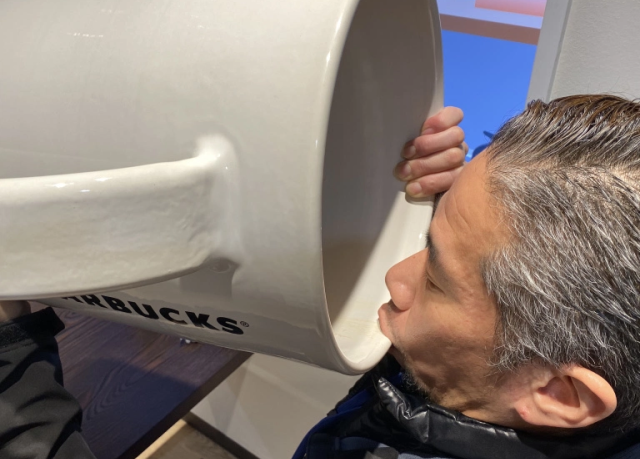
Wake up and smell the genomes.
As the old saying goes, “you are what you eat,” but recent research is showing that “we eat what we are” might be more accurate. In other words, our tastes and dietary habits might have more to do with what’s embedded in our DNA than we had previously thought.
One gene that has been of particular interest is ALDH2, which controls the enzymes used in alcohol metabolism. This is the same gene that results in redness that appears on the faces of many East Asians who partake of alcohol, but now is believed to be related to a number of other traits from alcohol dependence to quality of sleep, as well as other dietary preferences.
▼ Mr. Sato appears to have the ALDH2 genotype that processes alcohol fully, as his face remains fair after drinking. They only way you could tell he was wasted was the way he eats grated garlic from a jar.
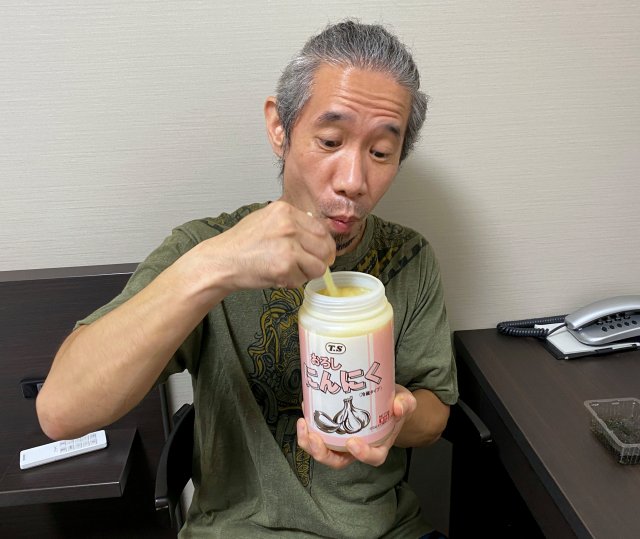
For example, according to Tokyo-based genome data analysis firm Euglena, the rs671 genotypes of ALDH2 have a relation to the amount of coffee someone likes to consume on a daily basis. Euglena then used the data of 20,000 people from all over Japan and found which prefectures have the most and least number of genetically predisposed coffee lovers.
They also illustrated the results in this playfully coffee-colored heat map, in which darker areas represent the highest population of coffee-craving genotypes and vice versa.
As we can see, there is a considerably stronger concentration of these people in the western part of Japan, particularly the Kansai region, composed of prefectures such as Osaka and Kyoto. As the detailed data reveals, four of the six main Kansai prefectures appear in the top ten genetically coffee-loving prefectures:
Prefectures with most people whose genes suggest they like coffee
1. Wakayama
2. Mie
3. Aichi
4. Gifu
5. Kyoto
6. Nara
7. Fukui
8 (tie). Osaka, Yamaguchi
10 (tie). Kagawa, Saga
Other prefectures like Mie and Fukui are sometimes grouped in with the Kansai area as well bringing the total up to six.
Conversely, the geographic extremities of Japan also seem to be the less susceptible to the aroma of freshly brewed coffee. The southern islands of Okinawa came in dead last among prefectures and northernmost Hokkaido ranked 41st out of 47.
▼ Full ranking in English listed at the end of this article
Interestingly, according to economic census data from the Ministry of Internal Affairs and Communication many of the same prefectures that tested highly for genetic predilection for coffee also have the most coffee shops per capita.
Prefectures with most coffee shops per capita (shops/1,000 people)
1. Kochi (1.56)
2. Gifu (1.43)
3 (tie). Aichi, Wakayama (1.13)
5. Osaka (1.06)
6. Hyogo (0.97)
7. Kagawa (0.93)
8. Kyoto (0.92)
9. Mie (0.86)
10. Fukui (0.83)
Although not in the top ten, Kochi was still a respectable 16th in terms of coffee-drinking genes. Its first-place performance here might also have been swayed by it having the third-lowest population in the country. Hyogo, on the other hand, is pretty far down the list at 23rd place but percentage-wise isn’t too far away from Kochi in terms of people with the genotypes in question.
In the end, this data does little more than provide some fun and perhaps highlight some prime opportunities to open coffee shops in Wakayama and Mie. But more importantly, the science behind it is bringing us closer to identifying potential lifestyle illnesses we might be at risk of falling victim to one on a genetic level without ever realizing it.
Full list of Japanese prefectures ranked by population of people genetically predisposed to drink coffee (percentage of population)
1.Wakayama (9.92)
2. Mie (9.3)
3. Aichi (8.82)
4. Gifu (8.76)
5. Kyoto (8.29)
6. Nara (8.04)
7. Fukui (7.24)
8 (tie). Osaka, Yamaguchi (7.21)
10 (tie). Kagawa, Saga (7.18)
12. Shizuoka (7.1)
13. Kanagawa (7.05)
14. Toyama (6.81)
15. Gunma (6.45)
16. Kochi (6.38)
17 (tie). Ibaraki, Nagasaki (6.35)
19. Okayama (6.33)
20. Fukuoka (6.3)
21. Chiba (6.25)
22. Tokushima (6.18)
23 (tie). Shimane, Hyogo, Yamanashi (6.15)
26. Ishikawa (6.13)
27. Nagano (6.1)
28. Ehime (6.08)
29. Tokyo (5.88)
30 (tie). Saitama, Miyazaki (5.62)
32. Hiroshima (5.38)
33. Tochigi (5.34)
34. Oita (5.24)
35. Kumamoto (5.15)
36. Fukushima (5.13)
37. Niigata (4.91)
38. Kagoshima (4.8)
39. Shiga (4.71)
40. Tottori (4.37)
41. Hokkaido (4.35)
42. Yamagata (3.53)
43. Iwate (3.42)
44. Miyagi (3.42)
45. Akita (2.96)
46. Aomori (2.84)
47. Okinawa (2.66)
Source: PR Times
Top image: ©SoraNews24
Insert images: PR Times (unless otherwise noted)
● Want to hear about SoraNews24’s latest articles as soon as they’re published? Follow us on Facebook and Twitter!

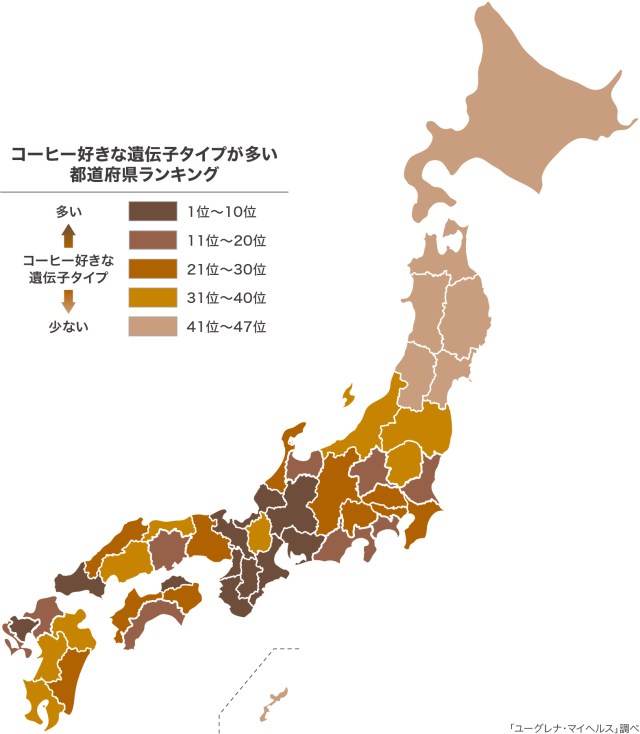
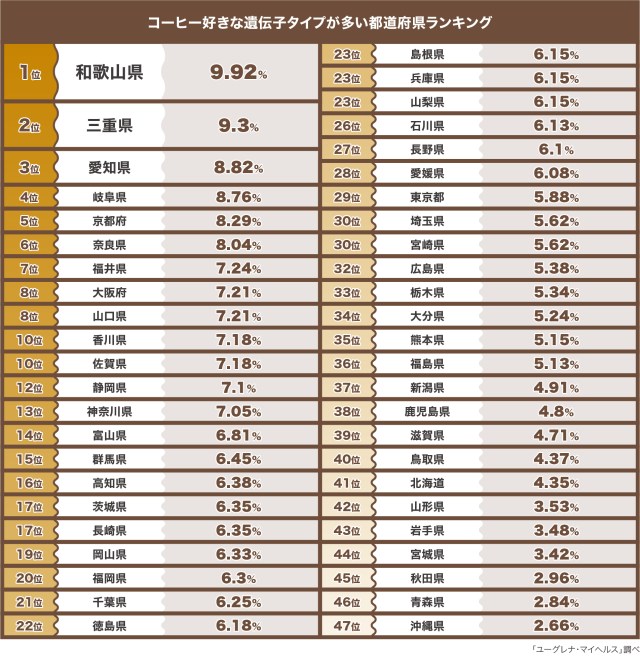
 Online survey sheds light on prefectural personality rankings of Japanese people
Online survey sheds light on prefectural personality rankings of Japanese people Japan’s favorite Pokémon types by prefecture–which types are the most popular?
Japan’s favorite Pokémon types by prefecture–which types are the most popular? Rakuten randomly offers 58 New Year’s osechi feasts in Japan, but did we get a star or a dud?
Rakuten randomly offers 58 New Year’s osechi feasts in Japan, but did we get a star or a dud? Japanese beef bowl chain Sukiya’s 2026 Smile Box lucky bag basically pays for itself
Japanese beef bowl chain Sukiya’s 2026 Smile Box lucky bag basically pays for itself Majority of Japanese mayors say foreign residents are essential but most see good and bad effects
Majority of Japanese mayors say foreign residents are essential but most see good and bad effects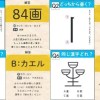 What does a kanji with 12 “kuchi” radicals mean? A look at weird, forgotten Japanese characters
What does a kanji with 12 “kuchi” radicals mean? A look at weird, forgotten Japanese characters This ornate Super Mario Bros. watch can be yours for just, oh, US$27,000
This ornate Super Mario Bros. watch can be yours for just, oh, US$27,000 Artist shares a glimpse of a world where the Pokémon Eevee is real
Artist shares a glimpse of a world where the Pokémon Eevee is real Four Shinto shrines to pray for love at in Japan to start the New Year
Four Shinto shrines to pray for love at in Japan to start the New Year More people in Japan quit sending New Year’s cards and many have started to regret it
More people in Japan quit sending New Year’s cards and many have started to regret it Japanese mouthwash effective against coronavirus, according to Osaka Governor
Japanese mouthwash effective against coronavirus, according to Osaka Governor Tokyo fish market breaks New Year auction record as single fish sells for over 5 million yen【Vid】
Tokyo fish market breaks New Year auction record as single fish sells for over 5 million yen【Vid】 Starbucks Japan ready to get Year of the Horse started with adorable drinkware and plushies【Pics】
Starbucks Japan ready to get Year of the Horse started with adorable drinkware and plushies【Pics】 Hayao Miyazaki says Happy New Year to Studio Ghibli fans with new art for Year of the Horse
Hayao Miyazaki says Happy New Year to Studio Ghibli fans with new art for Year of the Horse We found possibly the quietest Japanese-style hotel in Tokyo’s bustling Shinjuku district
We found possibly the quietest Japanese-style hotel in Tokyo’s bustling Shinjuku district Cup Noodle tries an authentic Jiro-style ramen, but something’s not quite right
Cup Noodle tries an authentic Jiro-style ramen, but something’s not quite right The best Starbucks Japan Frappuccinos we want to drink again in 2026
The best Starbucks Japan Frappuccinos we want to drink again in 2026 We revisited Sweets Paradise after a decade to see if Japan’s dessert buffet still delivers
We revisited Sweets Paradise after a decade to see if Japan’s dessert buffet still delivers That time Seiji called JASRAC to ask why he didn’t get paid royalties for his song being on TV
That time Seiji called JASRAC to ask why he didn’t get paid royalties for his song being on TV Japan’s oldest largetooth sawfish in captivity back on display in Mie Prefecture
Japan’s oldest largetooth sawfish in captivity back on display in Mie Prefecture Pizza Hut Japan’s hot lucky bags are perfect for a New Year’s pizza party
Pizza Hut Japan’s hot lucky bags are perfect for a New Year’s pizza party 7-Eleven Japan starts new temporary luggage storage service in over 300 branches
7-Eleven Japan starts new temporary luggage storage service in over 300 branches Disillusionment at Tsukiji’s tourist-target prices led us to a great ramen restaurant in Tokyo
Disillusionment at Tsukiji’s tourist-target prices led us to a great ramen restaurant in Tokyo Starbucks teams up with 166-year-old Kyoto doll maker for Year of the Horse decorations【Photos】
Starbucks teams up with 166-year-old Kyoto doll maker for Year of the Horse decorations【Photos】 Tokyo considering law requiring more trash cans following litter increase in heavily touristed area
Tokyo considering law requiring more trash cans following litter increase in heavily touristed area Tokyo’s Tsukiji sushi neighborhood asks tour groups to stay away for the rest of the month
Tokyo’s Tsukiji sushi neighborhood asks tour groups to stay away for the rest of the month Tokyo event lets you travel back in time, for free, to celebrate 100 years since Showa era start
Tokyo event lets you travel back in time, for free, to celebrate 100 years since Showa era start Japan may add Japanese language proficiency, lifestyle classes to permanent foreign resident requirements
Japan may add Japanese language proficiency, lifestyle classes to permanent foreign resident requirements Sanrio theme park in Japan announces plans to expand into a Sanrio resort
Sanrio theme park in Japan announces plans to expand into a Sanrio resort Stamina-destroying “Paralysis Noodles” are Tokyo’s newest over-the-top ramen innovation
Stamina-destroying “Paralysis Noodles” are Tokyo’s newest over-the-top ramen innovation Survey asks foreign tourists what bothered them in Japan, more than half gave same answer
Survey asks foreign tourists what bothered them in Japan, more than half gave same answer Japan’s human washing machines will go on sale to general public, demos to be held in Tokyo
Japan’s human washing machines will go on sale to general public, demos to be held in Tokyo Japan’s deadliest food claims more victims, but why do people keep eating it for New Year’s?
Japan’s deadliest food claims more victims, but why do people keep eating it for New Year’s? We deeply regret going into this tunnel on our walk in the mountains of Japan
We deeply regret going into this tunnel on our walk in the mountains of Japan Studio Ghibli releases Kodama forest spirits from Princess Mononoke to light up your home
Studio Ghibli releases Kodama forest spirits from Princess Mononoke to light up your home Major Japanese hotel chain says reservations via overseas booking sites may not be valid
Major Japanese hotel chain says reservations via overseas booking sites may not be valid Put sesame oil in your coffee? Japanese maker says it’s the best way to start your day【Taste test】
Put sesame oil in your coffee? Japanese maker says it’s the best way to start your day【Taste test】 No more using real katana for tourism activities, Japan’s National Police Agency says
No more using real katana for tourism activities, Japan’s National Police Agency says Starbucks Japan reveals new sakura drinkware collection, inspired by evening cherry blossoms
Starbucks Japan reveals new sakura drinkware collection, inspired by evening cherry blossoms Updated cherry blossom forecast shows extra-long sakura season for Japan this year
Updated cherry blossom forecast shows extra-long sakura season for Japan this year
Leave a Reply